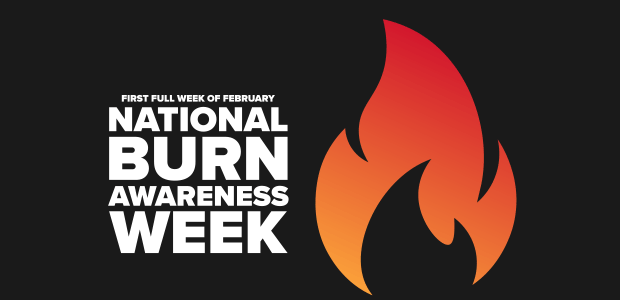It’s National Burn Awareness Week
Every year, the American Burn Association recognizes the first full week in February as National Burn Awareness Week; this year’s theme focuses on the burns caused by flammable liquids.
We live in a world where flammable and combustible liquids are common and used frequently – gasoline, rubbing alcohol, nail polish remover, lighter fluid, hand sanitizer, and cooking oils are just a few examples.
NYCHA’s Environmental Health and Safety Department (EHS) would like to share the following ways to stay safe at work from flammable liquids. NYCHA personnel can review the safety data sheets (SDS) for various materials in the SafeNYCHA section of Connect [click “SafeNYCHA” under the “Departments” tab at the top of the home page and then “Finding Safety Data Sheets (SDS)”]. The SDS explain hazards associated with handling chemical products and how to use them safely.
NYCHA employees should keep in mind:
- The quantity of flammable or combustible liquids being stored and how the they are being stored, whether it is rack storage, shelf storage palletized, or stacked.
- Fire prevention is especially important when flammable and combustible liquids are used. Make sure you understand how to identify, handle, and store flammable and combustible liquids.
- The type of containers for flammable and combustible liquids can be stored in varies greatly; some examples of acceptable container material include metal, plastic, or glass. The storage container material will also dictate the volume of the container that the liquid can be stored in.
- To avoid dangerous sparks caused by static electricity, containers of flammable liquids must be properly grounded and bonded while dispensing the liquid.
- Fire extinguishers must be available where flammable and combustible liquids are stored. Always observe “no smoking” signs where these liquids are present.
OSHA’s labeling chart for flammable and combustible liquids with their symbols:
|
Flame |
Danger |
Warning |
Extremely Flammable Liquid & Vapor |
Highly Flammable Liquid |
Combustible Liquid |
|
|
Symbol |
 |
 |
 |
 |
 |
 |
|
Category I |
Peanut oil |
Peanut oil |
Rubbing alcohol |
Grease |
|
|
|
Category II |
|
Oxidizer |
|
Grease |
Methane |
Camphor oil |
|
Category III |
|
|
|
Natural Gas |
Acetone |
Acetone |
|
Category IV |
|
|
|
|
|
Fuel oil |
Storing flammable liquids safely:
Per NYCHA Standard Procedure 158:02:1 “Hazard Communication Procedure (HAZCOM)”:
- Proper chemical storage requires routine inspections of chemical storage areas and stringent inventory control.
- Location supervisors shall ensure that:
- All chemical storage areas and cabinets at their work location are inspected once per year.
- Any unwanted or expired chemicals are removed.
- All chemicals are stored according to the handling and storage information listed on the safety data sheets.
- All containers of hazardous chemicals at their location are properly labeled for easy identification of their contents.
- Chemical storage cabinets and chemical storage rooms keeping flammable chemicals have prominent signs that read FLAMMABLE – KEEP FIRE AWAY to alert the fire department in case of an emergency (e.g., fire, explosion).
- All incompatible chemicals are segregated by hazard class. Hazard class information can be found on the safety data sheet for every chemical.
- Stored chemicals are not sorted alphabetically unless already within a grouping of compatible chemicals.
- Flammable chemical substances are stored in an approved, dedicated flammable materials storage cabinet or storage room if the volume exceeds 10 gallons.
- The cabinet doors are kept closed while the chemicals are not in use.
- Chemicals are stored no higher than eye level, and never on the top shelf. Storage unit shelves are not overcrowded with chemical containers.
- Chemicals are never stored on the floor or extending into traffic aisles.
- Liquid chemicals are either stored n unbreakable or double-contained packaging, or the storage unit is capable of holding the contents if the container breaks.
- Chemical acids are stored in a dedicated acid storage cabinet. Nitric acid may be stored there as well, as long as it is kept isolated from all other acids.
- Highly toxic or controlled chemical substances are stored in a locked, dedicated poison cabinet.
- Volatile or highly odorous chemicals are stored in a ventilated cabinet.
- Chemical fume hoods are not used for storage as containers block proper air flow in the hood and reduce available workspace.
- All stored chemicals, especially flammable liquids, are kept away from heat and direct sunlight.
Disposing of flammable liquids safely:
- Never pour these liquids down the drain or into a sewer.
- Contact a hazardous material or chemical waste disposal company to get rid of highly flammable liquids. You can also take them to a SAFE Disposal Event, which are normally held by the City in the spring and fall (learn more here).
For additional guidance on handling flammable liquids and chemicals, please review Standard Procedure 040.04:3 and the SafeNYCHA Advisories on NYCHA Connect (click “SafeNYCHA” under the “Departments” tab at the top of the home page).
For more information on flammable liquid safety and burn awareness, please







